L | A (Translated with ChatGPT)
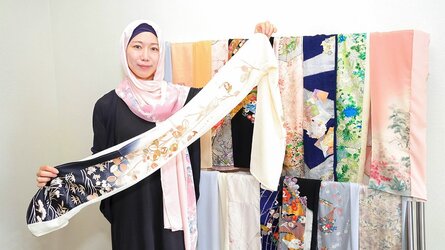
Kaori Kobayashi holding a kimono hijab
The kimono, a traditional Japanese garment, and the hijab, worn by Muslim women (Muslima) to cover their hair, may seem unrelated. However, there is a Japanese woman who has found common ground between the two and advocates for mutual understanding between cultures.
We spoke with Kaori Kobayashi, who is involved in the creation and sale of 'kimono hijabs,' to understand what drives her and what her thoughts are behind this initiative.
The commonality is "beauty"
It all began in January 2017, during a trip to Malaysia. It was Kaori Kobayashi’s first time visiting an Islamic region, and until then, she had held a rather plain image of the hijab.
However, the hijabs worn by the Muslim women walking through the streets and those displayed in the markets were, contrary to her expectations, vibrant in color and rich in design. She was stunned by their sheer beauty.

Kaori Kobayashi during her trip to Malaysia
In that moment, the idea struck her: 'What if I made hijabs using antique kimonos?'
'I majored in Japanese history in university and researched the customs of the early Showa period. Kimonos from the Taisho to early Showa periods often feature bright colors and bold patterns, and I instinctively felt that the hijab and kimono share a similar beauty.'
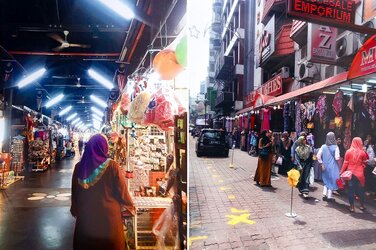
Colorful hijabs photographed by Kaori Kobayashi in Malaysia
"I decided, “I'm going to buy a sewing machine as soon as I get back!'"
"Although I loved looking at kimonos, I didn't have much knowledge about them. Still, I felt an overwhelming urge to create something. During the trip, I declared to my husband, 'I'm going to buy a sewing machine when we get back.'
Right after returning to Japan, I received some old kimonos that had been stored at my grandmother’s house. An idea came to me to combine kimono fabric with different materials, so I bought some lightweight fabric at a craft store. I hadn’t sewn anything since home economics class in school, but I simply cut the kimono into strips as I had imagined and stitched them together.
'At first, it was more like a hobby. Once I finished a hijab, I would list it on a flea market website (an online marketplace), selling maybe one or two per month. Although I was self-taught in sewing, I kept experimenting and researching ways to improve my work.'

"I look back and realize, 'I had no connection to Islamic culture at all.'"
"When I asked about hijabs on social media, I received responses from Muslim women around the world, some of whom even offered to meet in person to teach me. All the Muslims I interacted with were kind.
'Despite that, when I mentioned that I wanted to visit a mosque, people around me warned me that it was 'dangerous.''
At that time, the news was heavily reporting on terrorist activities by the extremist group 'ISIS' happening around the world, which likely influenced their reactions.
'There was a widespread impression that 'Islam is scary.' The most painful part was not being able to gain the understanding of those close to me. There were even acquaintances who asked me, 'Why would you want to associate with Muslims?'
'The hijab belongs to everyone"
In 2012, when I accompanied my husband on his assignment in Shanghai, I had the exact opposite experience. Anti-Japanese sentiments were rising, and there was increased caution about going outside dressed in a way that revealed one's Japanese identity. However, the people in the city were warm, and I strongly felt that 'the reports and reality are different.'
Had it not been for the opportunity to interact through hijabs, I might have misunderstood Muslims myself. I wondered if a lack of knowledge was breeding prejudice.
'I have a Buddhist altar at home, but I don't hold particularly strong religious beliefs. I was drawn to the mysterious aura and fashion of the hijab and began making them, but I often questioned, 'Is it okay for someone who is not a Muslim to make and wear a hijab?'
When I expressed such doubts, the Muslim women all encouraged me, saying, 'The hijab belongs to everyone.' Anyone can make or wear it. The Islamic world was more welcoming than I had thought. As my worries dissipated, my desire to eliminate the preconceived notions that 'Muslims are scary' grew stronger.
Casual enjoyment of kimono through "sha"
The hijabs I saw in the hot and humid Malaysia were made of light chiffon fabric, creating beautiful, flowing drapes.
Japanese kimonos also have lightweight fabrics suitable for the muggy summer, such as 'ro' and 'sha.' Sha is lighter, more breathable, and has a stronger sheer quality. While ro is meant for formal attire, sha is suited for casual wear."
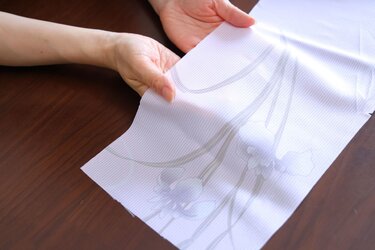
Sha is a type of fabric. It has a sheer quality and feels cool
Even among Japanese people, there are not many who wear kimonos regularly. While transforming kimonos into hijabs makes them more accessible, the thick and heavy fabric of kimonos presents a challenge. 'By combining it with chiffon fabric and creating a light, flowing hijab, everyone can enjoy the beauty of kimonos casually.'
The concept of Kaori Kobayashi's kimono hijab perfectly aligned with the image of 'sha,' which is light and suitable for everyday use. She named her shop 'Sasha xiaxia hijab Japan' (hereafter referred to as 'Sasha') and established an online store just nine months after returning from her trip.
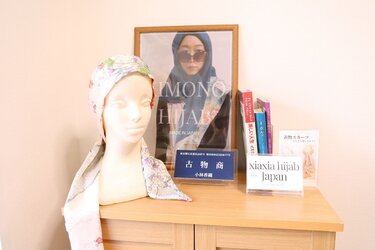
She also obtained a secondhand dealer's license to buy kimonos
Kimono + Hijab = Upcycling
As more people discovered and purchased from her small personal online shop, she began receiving messages of gratitude, saying, 'Thank you for making these.' The colors and patterns of traditional Japanese kimonos are very popular overseas, and many people buy them as gifts.
'While motifs that are distinctly Japanese are favored, there are also many patterns that are standard in Japan but are not religiously appropriate in Islam. I continue to learn and experiment every day.'

Patterns that are distinctly Japanese are popular, with pink being the most favored color
She sources kimonos by visiting familiar secondhand shops. The designs that Kaori Kobayashi feels are suitable for hijabs are not the typical 'best sellers,' so she is often welcomed when she goes to purchase them. Making hijabs from antique kimonos is an environmentally friendly form of upcycling and aligns with contemporary trends.

The antique kimonos she sources mainly feature vibrant colors and patterns
Each piece is unique, with no two having the same colors or patterns.
The kimonos she acquires are first completely unraveled. As a result, they can be divided into about nine pieces of varying sizes. Only the outer fabric is used for the hijabs, while the lining is not utilized.

When the threads are unraveled, everything becomes square pieces of fabric
Kimonos are usually made of delicate silk, so they are generally hand-washed with only water. For those that are heavily soiled, a small amount of detergent may be used or spot cleaning may be required, which takes some effort. After air-drying, they are washed again, and then ironed.
The damaged parts are removed before cutting. Depending on the condition, about five to ten pieces of fabric suitable for hijabs can be obtained.
From there, she considers the design. Since no two kimonos are the same, each piece is 'one-of-a-kind.' 'Deciding which colors to pair and considering the fabric's thickness is the most enjoyable part of the process,' she says.
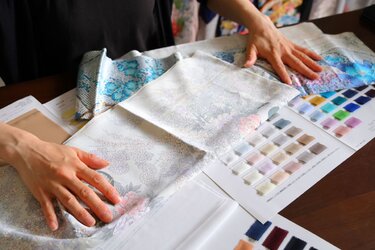
She decides on the design by comparing it with color samples

Sewing different materials together neatly is a challenging task
Video Becomes a Turning Point for a Major Hit
In April 2020, as the COVID-19 pandemic led to a state of emergency, the number of inbound tourists plummeted. Amid the chaos, Kaori Kobayashi also fell ill, but she continued her diligent production with the thought that 'as long as someone is happy.'
In May 2022, she opened a shop at an antenna shop in Tama, Tokyo, marking the start of her physical retail sales. In 2023, as tourists returned, she placed her products at a tourist information center in Harajuku, where popularity surged. By the end of that year, another turning point arrived.
'A video that I happened to help create for inbound tourists went viral. It was released on December 30, and by January 2, I received a call from the Harajuku store saying they had run out of stock. After that, I was incredibly busy.'
'I hardly slept until around spring,' adds her husband, Keita. Keita works in sales for an information-related company. He has started to support his wife, utilizing his networking skills.

Keita helps with his wife's increasingly busy work
Feeling that 'understanding is progressing'
This year marks the seventh year since she started her business as Sasha. In March, she expanded her sales channels to 'Toyosu Senkyaku Bankai,' and in May, she also began selling at a halal shop in Asakusa, Tokyo. Including online orders, she now produces nearly 100 kimono hijabs a month.
Although she has started outsourcing some processes due to a lack of manpower, Kobayashi still handles most of the operations, from purchasing kimonos and chiffon fabric to design, order processing, and shipping.

Staff responsible for Arabic also wear kimono hijabs
Most of the customers at the store are inbound tourists from abroad. Initially, many came from Southeast Asia, but there is now demand from tourists from the United States, the Middle East, and Europe as well.
'Compared to seven years ago, there are now more halal food stores and women wearing hijabs in Japan. Understanding of Islamic culture has progressed more than before. When I explain my activities to friends, what used to be met with strange looks now receives responses like, 'That's amazing!' One day, we may come to know Muslims more closely in our workplaces and neighborhoods. It’s essential that we get to know each other better.'
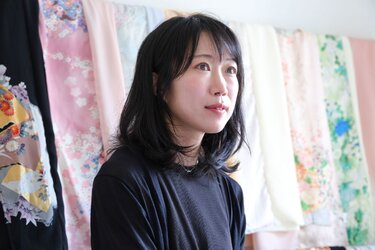
She raises the issue that 'the lack of opportunities to know each other is the problem.'
"True beauty knows no borders"
Kaori Kobayashi passionately expresses her desire to promote her brand as a 'hijab brand from Japan.' There is a strong demand for abayas, long Islamic garments that cover the entire body, coordinated with hijabs, with many requests to 'create matching sets.' She is eager to meet the expectations of customers who have come to appreciate the beauty of kimonos.
'I believe that combining beautiful things, like kimono hijabs, can serve as a gateway to positively understanding each other's cultures.'
The motto displayed on the Sasha website is 'True Beauty Knows No Borders.' Kaori Kobayashi, who has found a way to bridge Japan and Islamic culture, continues to pursue her dreams."
Sasha xiaxia hijab Japan
Official website: https://xiaxiahijab.com/
Online shop: https://xiaori.thebase.in/

Kaori Kobayashi holding a kimono hijab
The kimono, a traditional Japanese garment, and the hijab, worn by Muslim women (Muslima) to cover their hair, may seem unrelated. However, there is a Japanese woman who has found common ground between the two and advocates for mutual understanding between cultures.
We spoke with Kaori Kobayashi, who is involved in the creation and sale of 'kimono hijabs,' to understand what drives her and what her thoughts are behind this initiative.
The commonality is "beauty"
It all began in January 2017, during a trip to Malaysia. It was Kaori Kobayashi’s first time visiting an Islamic region, and until then, she had held a rather plain image of the hijab.
However, the hijabs worn by the Muslim women walking through the streets and those displayed in the markets were, contrary to her expectations, vibrant in color and rich in design. She was stunned by their sheer beauty.

Kaori Kobayashi during her trip to Malaysia
In that moment, the idea struck her: 'What if I made hijabs using antique kimonos?'
'I majored in Japanese history in university and researched the customs of the early Showa period. Kimonos from the Taisho to early Showa periods often feature bright colors and bold patterns, and I instinctively felt that the hijab and kimono share a similar beauty.'

Colorful hijabs photographed by Kaori Kobayashi in Malaysia
"I decided, “I'm going to buy a sewing machine as soon as I get back!'"
"Although I loved looking at kimonos, I didn't have much knowledge about them. Still, I felt an overwhelming urge to create something. During the trip, I declared to my husband, 'I'm going to buy a sewing machine when we get back.'
Right after returning to Japan, I received some old kimonos that had been stored at my grandmother’s house. An idea came to me to combine kimono fabric with different materials, so I bought some lightweight fabric at a craft store. I hadn’t sewn anything since home economics class in school, but I simply cut the kimono into strips as I had imagined and stitched them together.
'At first, it was more like a hobby. Once I finished a hijab, I would list it on a flea market website (an online marketplace), selling maybe one or two per month. Although I was self-taught in sewing, I kept experimenting and researching ways to improve my work.'

"I look back and realize, 'I had no connection to Islamic culture at all.'"
"When I asked about hijabs on social media, I received responses from Muslim women around the world, some of whom even offered to meet in person to teach me. All the Muslims I interacted with were kind.
'Despite that, when I mentioned that I wanted to visit a mosque, people around me warned me that it was 'dangerous.''
At that time, the news was heavily reporting on terrorist activities by the extremist group 'ISIS' happening around the world, which likely influenced their reactions.
'There was a widespread impression that 'Islam is scary.' The most painful part was not being able to gain the understanding of those close to me. There were even acquaintances who asked me, 'Why would you want to associate with Muslims?'
'The hijab belongs to everyone"
In 2012, when I accompanied my husband on his assignment in Shanghai, I had the exact opposite experience. Anti-Japanese sentiments were rising, and there was increased caution about going outside dressed in a way that revealed one's Japanese identity. However, the people in the city were warm, and I strongly felt that 'the reports and reality are different.'
Had it not been for the opportunity to interact through hijabs, I might have misunderstood Muslims myself. I wondered if a lack of knowledge was breeding prejudice.
'I have a Buddhist altar at home, but I don't hold particularly strong religious beliefs. I was drawn to the mysterious aura and fashion of the hijab and began making them, but I often questioned, 'Is it okay for someone who is not a Muslim to make and wear a hijab?'
When I expressed such doubts, the Muslim women all encouraged me, saying, 'The hijab belongs to everyone.' Anyone can make or wear it. The Islamic world was more welcoming than I had thought. As my worries dissipated, my desire to eliminate the preconceived notions that 'Muslims are scary' grew stronger.
Casual enjoyment of kimono through "sha"
The hijabs I saw in the hot and humid Malaysia were made of light chiffon fabric, creating beautiful, flowing drapes.
Japanese kimonos also have lightweight fabrics suitable for the muggy summer, such as 'ro' and 'sha.' Sha is lighter, more breathable, and has a stronger sheer quality. While ro is meant for formal attire, sha is suited for casual wear."

Sha is a type of fabric. It has a sheer quality and feels cool
Even among Japanese people, there are not many who wear kimonos regularly. While transforming kimonos into hijabs makes them more accessible, the thick and heavy fabric of kimonos presents a challenge. 'By combining it with chiffon fabric and creating a light, flowing hijab, everyone can enjoy the beauty of kimonos casually.'
The concept of Kaori Kobayashi's kimono hijab perfectly aligned with the image of 'sha,' which is light and suitable for everyday use. She named her shop 'Sasha xiaxia hijab Japan' (hereafter referred to as 'Sasha') and established an online store just nine months after returning from her trip.

She also obtained a secondhand dealer's license to buy kimonos
Kimono + Hijab = Upcycling
As more people discovered and purchased from her small personal online shop, she began receiving messages of gratitude, saying, 'Thank you for making these.' The colors and patterns of traditional Japanese kimonos are very popular overseas, and many people buy them as gifts.
'While motifs that are distinctly Japanese are favored, there are also many patterns that are standard in Japan but are not religiously appropriate in Islam. I continue to learn and experiment every day.'

Patterns that are distinctly Japanese are popular, with pink being the most favored color
She sources kimonos by visiting familiar secondhand shops. The designs that Kaori Kobayashi feels are suitable for hijabs are not the typical 'best sellers,' so she is often welcomed when she goes to purchase them. Making hijabs from antique kimonos is an environmentally friendly form of upcycling and aligns with contemporary trends.

The antique kimonos she sources mainly feature vibrant colors and patterns
Each piece is unique, with no two having the same colors or patterns.
The kimonos she acquires are first completely unraveled. As a result, they can be divided into about nine pieces of varying sizes. Only the outer fabric is used for the hijabs, while the lining is not utilized.

When the threads are unraveled, everything becomes square pieces of fabric
Kimonos are usually made of delicate silk, so they are generally hand-washed with only water. For those that are heavily soiled, a small amount of detergent may be used or spot cleaning may be required, which takes some effort. After air-drying, they are washed again, and then ironed.
The damaged parts are removed before cutting. Depending on the condition, about five to ten pieces of fabric suitable for hijabs can be obtained.
From there, she considers the design. Since no two kimonos are the same, each piece is 'one-of-a-kind.' 'Deciding which colors to pair and considering the fabric's thickness is the most enjoyable part of the process,' she says.

She decides on the design by comparing it with color samples

Sewing different materials together neatly is a challenging task
Video Becomes a Turning Point for a Major Hit
In April 2020, as the COVID-19 pandemic led to a state of emergency, the number of inbound tourists plummeted. Amid the chaos, Kaori Kobayashi also fell ill, but she continued her diligent production with the thought that 'as long as someone is happy.'
In May 2022, she opened a shop at an antenna shop in Tama, Tokyo, marking the start of her physical retail sales. In 2023, as tourists returned, she placed her products at a tourist information center in Harajuku, where popularity surged. By the end of that year, another turning point arrived.
'A video that I happened to help create for inbound tourists went viral. It was released on December 30, and by January 2, I received a call from the Harajuku store saying they had run out of stock. After that, I was incredibly busy.'
'I hardly slept until around spring,' adds her husband, Keita. Keita works in sales for an information-related company. He has started to support his wife, utilizing his networking skills.

Keita helps with his wife's increasingly busy work
Feeling that 'understanding is progressing'
This year marks the seventh year since she started her business as Sasha. In March, she expanded her sales channels to 'Toyosu Senkyaku Bankai,' and in May, she also began selling at a halal shop in Asakusa, Tokyo. Including online orders, she now produces nearly 100 kimono hijabs a month.
Although she has started outsourcing some processes due to a lack of manpower, Kobayashi still handles most of the operations, from purchasing kimonos and chiffon fabric to design, order processing, and shipping.

Staff responsible for Arabic also wear kimono hijabs
Most of the customers at the store are inbound tourists from abroad. Initially, many came from Southeast Asia, but there is now demand from tourists from the United States, the Middle East, and Europe as well.
'Compared to seven years ago, there are now more halal food stores and women wearing hijabs in Japan. Understanding of Islamic culture has progressed more than before. When I explain my activities to friends, what used to be met with strange looks now receives responses like, 'That's amazing!' One day, we may come to know Muslims more closely in our workplaces and neighborhoods. It’s essential that we get to know each other better.'

She raises the issue that 'the lack of opportunities to know each other is the problem.'
"True beauty knows no borders"
Kaori Kobayashi passionately expresses her desire to promote her brand as a 'hijab brand from Japan.' There is a strong demand for abayas, long Islamic garments that cover the entire body, coordinated with hijabs, with many requests to 'create matching sets.' She is eager to meet the expectations of customers who have come to appreciate the beauty of kimonos.
'I believe that combining beautiful things, like kimono hijabs, can serve as a gateway to positively understanding each other's cultures.'
The motto displayed on the Sasha website is 'True Beauty Knows No Borders.' Kaori Kobayashi, who has found a way to bridge Japan and Islamic culture, continues to pursue her dreams."
Sasha xiaxia hijab Japan
Official website: https://xiaxiahijab.com/
Online shop: https://xiaori.thebase.in/
